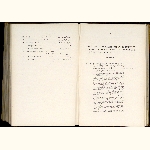Details of exhibit
- Exhibition:
- 1907 Fifty-second Annual Exhibition of the Royal Photographic Society of Great Britain
- Exhibit title:
- Photographs illustrating the life-history of a British Mud Wasp (Odynerus Spinipes). Figures 9, 10, 12, 13, 15, 16 are vertical sections, showing various burrows
- Exhibitor:
- Douglas English
- Section:
- Scientific and Technical Photography and its Application to Processes of Reproduction
- Exhibit No.:
- 317
- Description:
- The Mud-Wasp (Snap-wasp) Odynerus Spinipes is slightly smaller than the common wasp (13-14 mm. long) and of a darker appearance, owing to the narrowness of its yellow markings.
Illustration of the living insect (slightly enlarged) are given in Fig. 1, and in the insect to the central picture. The life-history is briefly as follows:-
The wasp excavates in sand or mud-soil, usually in sand cliffs with a southern aspect, a burrow some 40 mm. deep (Figs. 2, 3 10). The entrance of the burrow is crowned with a tubular projection, often curving downwards by its own weight (Fig. 11), which is extremely fragile, being composed of small gritty fragments of sand and stone lightly cemented together. (Fig. 4, 5, 6, etc.) The object of it is evidently to keep out parasitic hymenoptera, especially ruby-tails.
At the bottom of the burrow the wasp lays an egg, which is freely suspended from one side. (Fig. 9)
The burrow is then stocked with small green caterpillars destined to supply the wasp-grub with food.
These caterpillars are partially paralyzed by the wasp’s sting (? Formic acid), and, though incapable of any strong movement which might injure the grub, nevertheless remain alive until the grub devours them. All risk of putrefaction in the burrow is thus avoided. (Fig. 10, 12, etc.)
The wasp hunts some distance a-field for caterpillars and flies to the burrow entrance holding them clasped tight against the abdomen and thorax. (Fig 7, 8)
Supplies are brought for some days after the grub is hatched, sometimes as many as forty caterpillars in all. The wasp hunts in the hottest part of the day and brings back caterpillars at intervals of from a quarter of an hour to an hour and a half.
The number of caterpillars is in strict relation to their size, one large caterpillar (Fig. 9) being the equivalent of four or five small caterpillars. (Fig. 17)
Often, as soon as the existence of the grub is fairly established, the wasp constructs a partition midway down the shaft (Fig. 12, 13) as an additional precaution against parasites, but this is not invariable (Fig. 16)
When full fed the wasp-grub spins a cocoon (Fig. 13, 14) pupates, and finally works its own way out as the perfect insect. - Exhibit type:
- Photographic equipment and supplies
- Process:
- [Not Listed] ()
- Award:
- none

